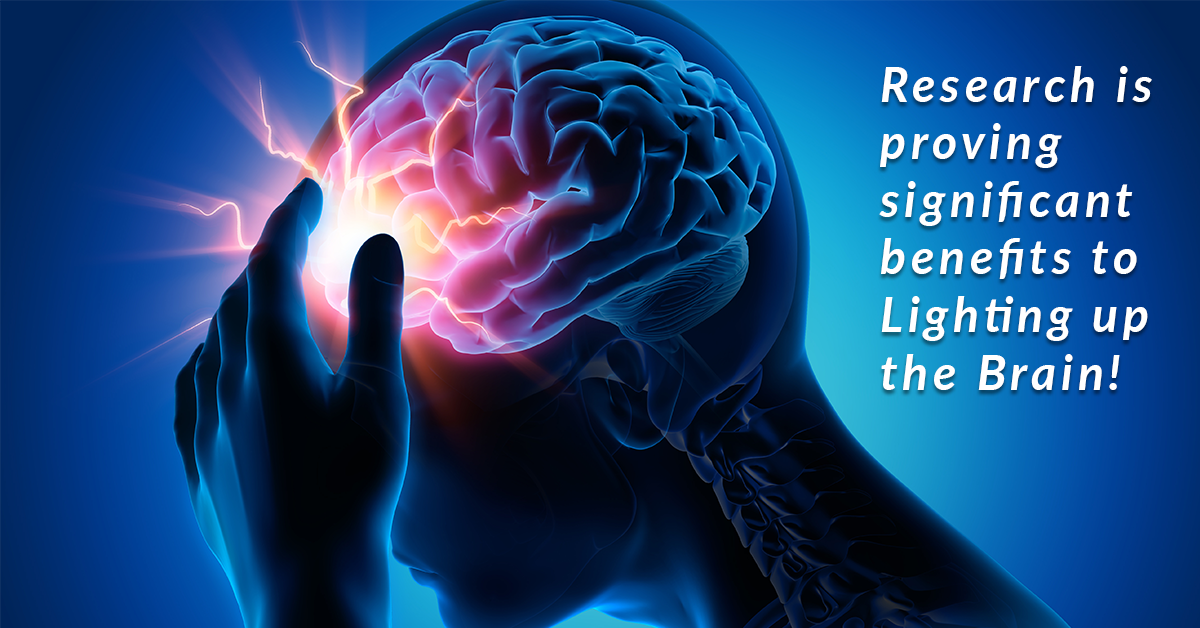Scientific studies using red and near-infrared light applied directly on the head have demonstrated:
- Cold Laser and LED light systems can offer enough power for photons to penetrate the skull in live patients.
- Near-infrared light increases circulation in cortical tissues.
- Significant improvements in depression and anxiety scores.
- Significant improvement in cognitive measures of study participants with TBI.
- Clear indications for neurological conditions including stroke, traumatic brain injury, degenerative brain disease, spinal cord injury, and peripheral nerve regeneration.
Brain Health Resources
Peer-Reviewed Articles:
- Traumatic Brain Injury: A Major Medical Problem That Could Be Treated Using Transcranial, Red/Near-Infrared LED Photobiomodulation – Photomedicine and Laser Surgery – September 1, 2015
- Can light therapy help the brain? – VA study with 160 Gulf War Veterans will test red, near-infrared light – March 31, 2015
- Transcranial LLLT may Improve Alertness and Awareness in Traumatic Brain Injured Subjects … Journal of Neurology and Neuroscience – June 3, 2015
Brain Health Videos
- Webinar with neurologist and Medical lead for InLight Medical, Dr.Greg Hipskind: The first 10 minutes is introductions so you can probably skip the first 10 minutes, if you want. If you prefer to watch just the videos from that webinar, the links are below:
- Dr. Daniel Amen: “The Most Important Lesson Learned From 83,000 Brain Scans” at 13:50 – https://www.youtube.com/watch?v=esPRsT-lmw8
- InLight Medical’s YouTube video on TBI: 46:17 minutes in – https://www.youtube.com/watch?v=VDGY6ciJFkQ&t=40s
“Talk About Light” conference calls dealing with Brain Health
A list of prerecorded conference calls sponsored by InLight Medical with Jody Mittiga (Adult Nurse Practitioner, Advanced Certified Hospice and Palliative Nurse, Doctor of Naturopathic Medicine) “Talk About Light” – https://www.talkaboutlight.com/tal-library/
- Brain Health Awareness Month Summary
- PLT & Dementia
- Brain Health
- Circulation & Brain Health
- PLT, Circulation and the Brain with Dr. Greg Hipskind (Part 1 & 2)
YouTube Testimonials
- 3 pretty amazing testimonials (one on TBI and one on bifurcating brain with wire): https://www.youtube.com/watch?v=0_uHTuyB6BM&list=PLod5Var9eiiKJkBPhYIvc6glbDBtjH3rj
Additional References
Eells, J.T., et al. (2003). Therapeutic photobiomodulation for methanol-induced retinal toxicity. Proc. Natl. Acad. Sci. U.S.A. 100, 3439–3444.
Hamblin, M.R. (2006). Mechanisms of low level light therapy. Proc SPIE. 6140:61001-61012.
Karu, T.I. & Kolyakov, S.F. (2005). Exact action spectra for cellular responses relevant to phototherapy. Photomed Laser Surg 23: 355–361.
Karu, T., Pyatibrat, L., Kalendo, G. (1995). Irradiation with He-Ne laser increases ATP level in cells cultivated in vitro. J Photochem Photobiol, B 27: 219–223.
Mi, X.Q., Chen, J.Y., Liang, Z.J., et al. (2004). In vitro effects of helium-neon laser irradiation on human blood: blood viscosity and deformability of erythrocytes. Photomed. Laser Surg. 22, 477–482.
Mi, X.Q., Chen, J.Y., Cen, Y., et al. (2004). A comparative study of 632.8 and 532nm laser irradiation on some rheological factors in human blood in vitro. J. Photochem. Photobiol. B 74, 7–12.
Naeser, M.A., Saltmarche, A., Krengel, M.H., Hamblin, M.R., and Knight, J.A. (2010). Transcranial LED therapy for cognitive dysfunction in chronic, mild traumatic brain injury: Two case report. Proc. of SPIE Vol. 7552, pp. 75520L1–12.
Naeser, M.A., Zafonte, R., Krengel, M.H., Martin, P. I., Frazier, J., Hamblin, M.R., Knight, J.A., Meehan, W.P., Baker, E.H. (2014). Significant Improvements in Cognitive Performance Post-Transcranial, Red/Near-Infrared Light-Emitting diode Treatments in Chronic, Mild Traumatic Brain Injury: Open-Protocol Study. J Neurotrauma 31:1008-1017.
Schiffer, F., Johnston, A.L., Ravichandran, C., et al. (2009). Psychological benefits 2 and 4 weeks after a single treatment with NIR light to the forehead: a pilot study of 10 patients with major depression and anxiety. Behav. Brain Funct. 5, 46.
Wan, S., Parrish, J.A., Anderson, R.R., and Madden, M. (1981). Transmittance of nonionizing radiatioPACKn in human tissues. Photochem Photobiol 34, 679–681.
Wong-Riley MT, Liang HL, Eells JT, Chance B, Henry MM, Buchmann E, Kane M & Whelan HT (2005). Photobiomodulation directly benefits primary neurons functionally inactivated by toxins: role of cyto- chrome c oxidase. J Biol Chem 280: 4761– 4771.

